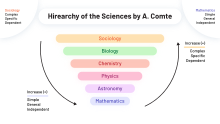Hierarchy of the sciences

The hierarchy of the sciences is a theory formulated by Auguste Comte in the 19th century. This theory states that science develops over time beginning with the simplest and most general scientific discipline, astronomy, which is the first to reach the "positive stage" (one of three in Comte's law of three stages). As one moves up the "hierarchy", this theory further states that sciences become more complex and less general, and that they will reach the positive stage later. Disciplines further up the hierarchy are said to depend more on the developments of their predecessors; the highest discipline on the hierarchy are the social sciences.[1][2] According to this theory, there are higher levels of consensus and faster rates of advancement in physics and other natural sciences than there are in the social sciences.[3]

Evidence[edit]
Research has shown that, after controlling for the number of hypotheses being tested, positive results are 2.3 times more likely in the social sciences than in the physical sciences.[4] It has also been found that the degree of scientific consensus is highest in the physical sciences, lowest in the social sciences, and intermediate in the biological sciences.[5] Dean Simonton argues that a composite measure of the scientific status of disciplines ranks psychology much closer to biology than to sociology.[6]
References[edit]
- ^ "Comte - The Work - Hierarchy of the Sciences". media.pfeiffer.edu. Retrieved 2018-05-06.
- ^ Bourdeau, Michel (2018-05-08). "4.2 The classification of the sciences and philosophy of science". Auguste Comte. Stanford Encyclopedia of Philosophy. Archived from the original on 2019-06-21.
- ^ Cole, Stephen (July 1983). "The Hierarchy of the Sciences?". American Journal of Sociology. 89 (1): 111–139. doi:10.1086/227835. ISSN 0002-9602. S2CID 144920176.
- ^ Fanelli, Daniele (2010-04-07). ""Positive" Results Increase Down the Hierarchy of the Sciences". PLOS ONE. 5 (4): e10068. Bibcode:2010PLoSO...510068F. doi:10.1371/journal.pone.0010068. PMC 2850928. PMID 20383332.
- ^ Fanelli, Daniele; Glänzel, Wolfgang (2013-06-26). "Bibliometric Evidence for a Hierarchy of the Sciences". PLOS ONE. 8 (6): e66938. Bibcode:2013PLoSO...866938F. doi:10.1371/journal.pone.0066938. PMC 3694152. PMID 23840557.
- ^ Simonton, Dean Keith (2004). "Psychology's Status as a Scientific Discipline: Its Empirical Placement Within an Implicit Hierarchy of the Sciences". Review of General Psychology. 8 (1): 59–67. doi:10.1037/1089-2680.8.1.59. S2CID 145134072.
